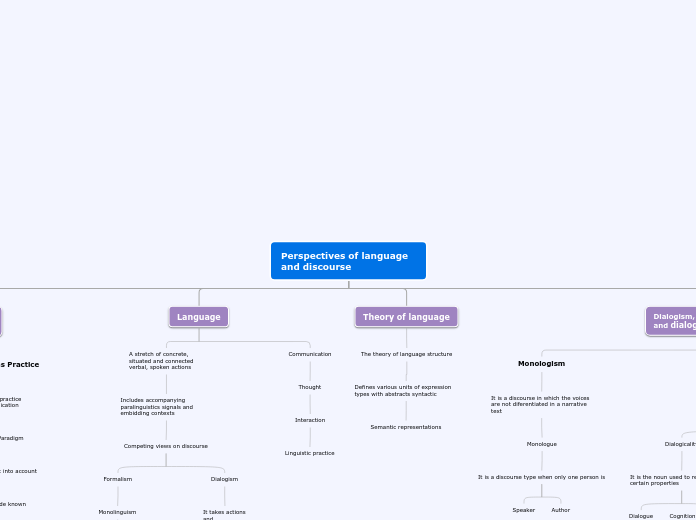Perspectives of language and discourse
Dialogism, dialogicality and dialogue
Expressing ideas or feelings in the form of dialogue
About any dyadic or polyadic interaction between individuals
Mutually co-present to each other
Interact through language
Dialogicality
It is the noun used to refer to certain properties
Cognition and communication
Dialogue
Monologism
It is a discourse in which the voices are not diferentiated in a narrative text
Monologue
It is a discourse type when only one person is
Author
Speaker
Theory of language
The theory of language structure
Defines various units of expression types with abstracts syntactic
Language
Communication
Thought
Interaction
Linguistic practice
A stretch of concrete, situated and connected verbal, spoken actions
Includes accompanying paralinguistics signals and embidding contexts
Competing views on discourse
Dialogism
It takes actions and interactions
Theory of human actions and activitie in cognitive and interactive contexts
Formalism
Monolinguism
The dominant paradigm in the language
It assumes individuals and societies to be analytical primes
It is the accepted mainstream epistemology of major traditions of the language science
Language as system vs. Language as practice
Language as Practice
Discourse, practice or communication
Formalist Paradigm
To take context into account
What is made known
What it said
Vocabulary
'Utterance', 'interpretation', 'message', 'context', etc.
It is seen as secondary 'language use'
Discourse Aspects
Language is seen as representational
Language as System
System or Structure
Formalist Framework
Linguistic expressions can be treated in abract
Semantic representations
Units of structure
Voucabulary
'Sentence', 'noun', 'grammatical subject', etc.









